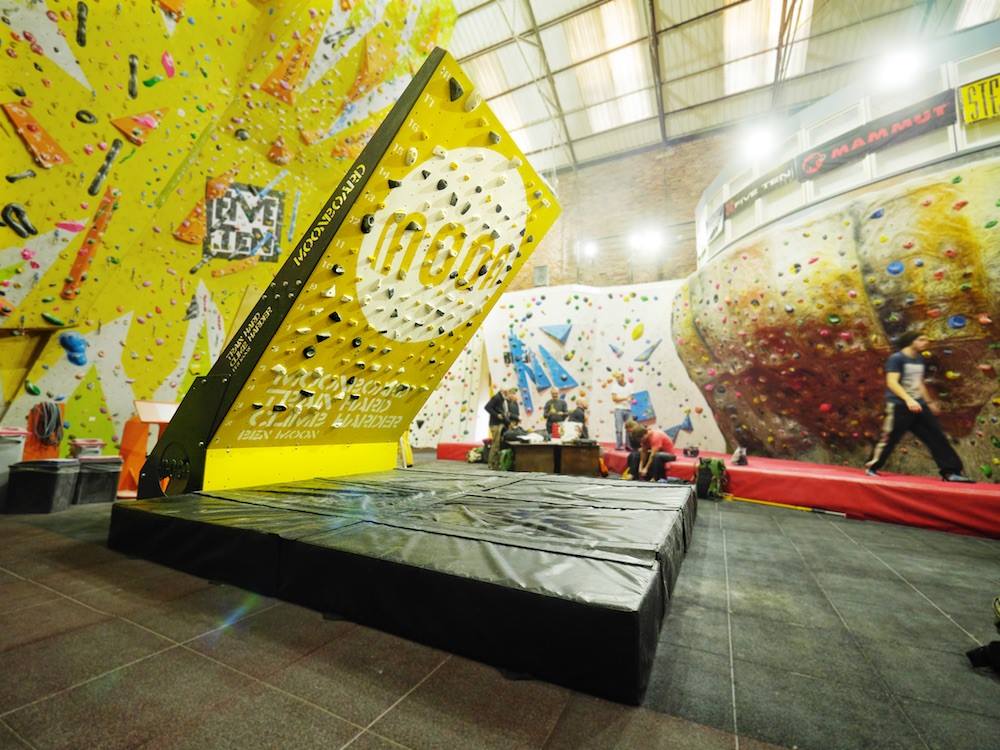While we’re always psyched on climbing, the sad reality is you don’t always have enough time to visit the crag, boulders, or even the gym—especially during the work week. Lucky for us, there are numerous ways to stay strong and build climbing fitness without leaving the house. Try some of our basement beta, and you’ll realize that training in the home gym during the work week can translate to sending on the weekend.

Hangboard
Hangboards are one of the most popular at-home training aids. While that might be because they’re small, easy to mount, and inexpensive, these devices are also very effective. Climbers literally hang from a variety of different-sized pockets and holds to build finger strength. As a side note, this is why hangboards are also sometimes called fingerboards.
Pull-Up Bar
Although less climbing-specific, a pull-up bar suits anyone who wants to take a break from their fingerboard, rest sore fingers, or simply work larger muscles. In fact, you can use it in all manners to build climbing strength. To start, the classic pull-up is a great exercise for increasing pulling power. Then, Frenchies—pausing to lock off at certain angles through the movement of a pull-up—are a fantastic method for building endurance and simulating the pause climbers take when clipping a bolt or placing gear. Allez!

Rock Rings
No room for a hangboard? Don’t have a wall you’re comfortable drilling into? Live a life on the go? If you answered yes to any of these questions, rock rings may be the best solution. Used as a pair, these individually molded grips are suspended using a cord that can be hung from any number of anchors. Think about a basement beam, a backyard tree, or even a swing set at the local park. Although lacking the diversity of a hangboard, rock rings let you move freely. In turn, the motion places less strain on your joints compared to doing pull-ups or Frenchies, which involve a fixed position that may be hard on the elbows.

Campus Board
If you have a bit more room available, consider a campus board. Wolfgang Güllich devised its simple, utilitarian, and effective design to train for sending the world’s first 9A, Action Directe. On a series evenly spaced rungs on a slightly overhanging wall, climbers move up and down without using their feet to primarily build power. Additionally, you can increase finger and core strength and improve accuracy when moving between holds. Because of the physical demands, it’s not recommended for new or young climbers.
Crack Machine
Climbers looking to crush cracks can build a crack machine to practice technique and gain strength. Simple and easy to construct, crack machines feature two stiff wooden boards mounted to resemble a crack. And, while advanced constructors will create adjustable machines, most basement builders will find it easier to create multiple cracks in the sizes they want to train—primarily finger and hand. The best part is, a little goes a long way, and you can climb both up and down when training.
Home Wall
For those with room to spare, a home wall is the way to go. From mild to wild, a home wall can range from a simple mounted piece of plywood to a full build rivaling the rock gym. Whether it’s freestanding or mounted to the wall, the most important components are the holds. Consider a wide variety of shapes and sizes for increased diversity and fun in setting. Overall, the best home walls tend to be the most frequently used ones and ultimately do their job—getting you strong for climbing.

Moon Board
For pro climbers and those truly dedicated to getting strong, try a Moon Board. Back in the ‘80s, legendary U.K. climber Ben Moon devised the first Moon Board in his basement in Sheffield, England, and by the 2000s, the trend had caught on. Compact and simple in design, Moon Boards have a uniform size and configuration: 8.06 feet wide, 10.40 feet high, and positioned at a 40-degree angle. The holds are placed in fixed locations, creating a wall that is the same, no matter where it’s located. Because of the universal layout, it’s possible to project the same route as your buddy across the country, or your favorite pro climber.
As such, serious climbers can find thousands of established problems posted on moonboard.com and the MoonBoard App. Even better, with the addition of an LED system, you can download and illuminate the problems to make route finding easier.
Books
Strong fingers and abs only get you so far, especially if your training plan is haphazard, your mental game is lacking, or your technical skills are weak. If any of that rings a bell, check out one of these books for training your brain.
- If you have the hangboard or home wall but are unsure of how to best use them, The Self-Coached Climber offers excellent advice for developing your own training plan. And, for something even more programmed, check out the training plans available from Uphill Athlete and the Mountain Tactical Institute.
- For climbers truly looking to train their mind, The Rock Warrior’s Way is an insightful read about mental training.
- The Mountain Guide Manual: The Comprehensive Reference—From Belaying to Rope Systems and Self-Rescue is an incredible technical skills guide that will greatly improve your climbing systems’ efficiency. Practice them at home, and you’ll find that you’ll have a lot more time to spend sending at the crag next weekend.
Have a training technique we didn’t mention? If so, tell us about it in the comments.
Tim Peck and Doug Martland
Tim and Doug met long ago at the Eastern Mountain Sports in Canton, Massachusetts. Bonding over a love of slick Quincy Quarry granite, White Mountain sufferfests, and scheming up adventures while folding tee-shirts, today Tim and Doug collaborate to write about their favorite outdoor activities and occasionally get nostalgic about tee-shirt tables.
Related Posts
April 2, 2024
10 Tips for Mountain Biking Etiquette During Mud Season
One rough spring could ruin the…




